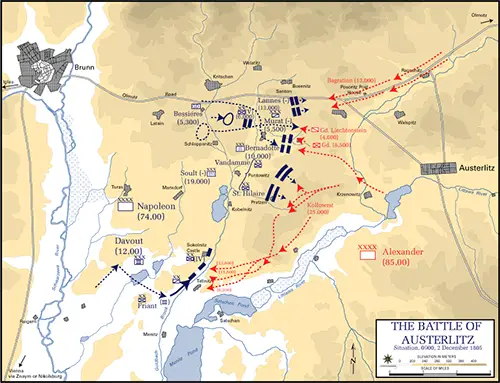The War of the Third Coalition
Part 3: Final Battle and Peace Even though Russia had joined the Third Coalition, Russian troops hadn't seen much action by this time. As French troops marched onward from Ulm toward Vienna (which they seized on November 14) and beyond into Moravia, they encountered Russian forces. One of the significant encounters in the days after the Austrian surrender at Ulm was in the Battle of Dürenstein, upstream from Vienna. Russians joined Austrians in opposing the French forces. Casualties were higher for the French side, losing one-third of its strength, than the allied force, under Russian Commander Mikhail Kutuzov. In practical terms, the battle was inconclusive. Joining the Russian forces at this time was the Russian emperor, Alexander I, who assumed overall military command. The Austrian emperor, Francis II, was on hand as well. (One of the names for this titanic battle was the Battle of the Three Emperors.) Disagreement between Austrian and Russian leaders and commanders resulted in an overall decision to fight, and a force of about 90,000 men occupied the Pratzen Plateau, west of Austerlitz. This was a key part of the Allied strategy, to concentrate on what was clearly a lack of strength on the French right. It certainly looked that way, which is how Bonaparte had devised it. His overall battle plan counted on the Allies' thinking the French right was weak and so attacking it, thereby leaving the center vulnerable. 
That is exactly what happened, on December 2. Sources disagree on exactly how many troops each side had. Estimates of Allied strength average just more than 80,000, and estimates of French strength suggest a few thousand less than that. Nearly half of the Allied force, 40,000 men, hit hard against the French right near the village of Telnitz, beginning at 8 a.m. A much smaller force of 10,500 under Marshal Louis-Nicolas Davout maintained the appearance of a stiff defense, with French artillery playing a key role in prolonging the Allied advance there. An Allied assault on the nearby town of Sokolnitz had similar results. At 9 a.m., a larger force, 20,000 strong, under Marshal Nicolas Soult stormed up the slopes of the Pratzen Plateau and launched themselves into the fray. The troops under Gen. Louis de Saint-Hilaire succeeded in taking the heights at the points of their bayonets but only after heavy fighting. At a critical moment, Bonaparte ordered a reserve force of 25,000 to shore up the Plateau. The result was an Allied army that was effectively split in two. Communication between allies was next to impossible. A fierce cavalry ensued, and French forces were victorious in this as well. As a final masterstroke, the French forces enveloped the Allied troops, forcing retreats everywhere. Individual commanders tried to fight their own way out, and chaos ensued. Only a desperate defense to Austrian cavalry prevented complete defeat. The damage had been done, however. Austria was well and truly defeated, and Russian forces were severely depleted. Allied casualties at the Battle of Austerlitz were 15,000 killed or wounded and 12,000 captured. French killed or wounded numbered about 8,000, and fewer than 600 French soldiers were captured. Arriving too late was the main part of the Austrian Army, sent to Italy in order to confront a major French invasion that never came. On December 4, Austria agreed to the Treaty of Pressburg, which required the payment of a very large indemnity and the transfer of ownership of large amounts of territory. With Austria out of the war, the Russian army went homeward. French troops, meanwhile, settled into winter camp in southern Germany. France had sent troops into Italy, of course, and so Archduke Charles and the Austrian he accompanied to Italy engaged French troops in battle, multiple times. As was the case elsewhere, superiority in numbers didn't always equate to victory, as French troops scored more than one victory despite having fewer troops to put in the field. Russian troops had joined U.K. troops in an occupation of Naples, beginning in summer 1805. When news of the French victory at Austerlitz reached Naples, the Russian troops there left relatively soon thereafter. U.K. troops left in January 1806. French troops under André Masséna invaded Naples in the following months and had relatively little trouble taking over, driving out the King of Naples, Ferdinand IV, and installing a new one, Joseph Bonaparte, brother of Napoleon. Russian troops withdrew to Corfu. The one negative in Italy for the French was an uprising in Calabria, which lasted for more than a year. Technically, the withdrawal of Austria from the fighting ended the War of the Third Coalition. Austria's allies continued the fighting, and it was only a few months later that the Fourth Coalition was formed. Part of the motivation for that was the abolition of the Holy Roman Empire and the advent of the Confederation of the Rhine. First page > From One War to the Next > Page 1, 2, 3 |
|
Social Studies for Kids
copyright 2002–2025
David White




